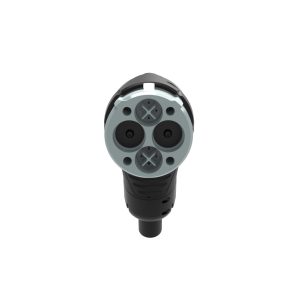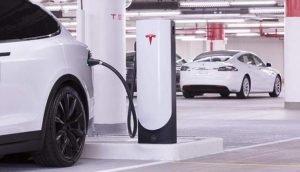With the growing popularity of electric vehicles (電動車), the diversity and functionality of charging infrastructure have become a key focus for EV owners. 特斯拉, a leading name in the EV industry, is known not only for its vehicle technology but also for its highly regarded charging solutions. Tesla provides both home chargers and commercial chargers, which differ significantly in terms of functionality, design, and application scenarios.

1. Overview of Tesla Home Chargers
1.1 Wall Connector
The Tesla Wall Connector is the primary home charging solution designed to offer an efficient and convenient charging experience at home.
High Power Output: The Wall Connector supports up to 15 kW of power (at 240V and 48A), capable of fully charging a Model S or Model X with longrange batteries in approximately 78 小時, or a Model 3 or Model Y in 45 小時.
Compact Design: It has a sleek design suitable for installation in home garages or parking spaces. Professional installation by an electrician is required to ensure compatibility and safety with the home electrical system.
Smart Features: The Wall Connector supports WiFi connectivity, allowing remote monitoring and management through the Tesla app, including viewing charging status and receiving software updates.
1.2 Mobile Connector
The Mobile Connector is Tesla’s portable charging solution, ideal for users who need the flexibility to charge anywhere.
Lower Power Output: It supports up to 4 kW of power (at 120V and 20A), suitable for lowpower, slow charging, mainly for emergency use or while traveling.
Portable and Versatile: The Mobile Connector is lightweight and easy to carry, can connect to standard household outlets, and provides great flexibility.
Adaptability: It can be equipped with different adapters to fit various power outlets, such as the NEMA 1450 適配器, which can provide up to 9.6 kW of power (at 240V and 40A).
2. Overview of Tesla Commercial Chargers
2.1 Destination Charging
Tesla’s Destination Charging network is designed to provide convenient charging services for EV owners on long journeys, often installed at hotels, restaurants, and shopping centers.
Similar to Wall Connector: Destination Chargers typically support up to 22 kW of power (depending on the grid configuration) and are suitable for use in locations where users are likely to stay for extended periods.
Business Responsibility: These chargers are installed and maintained by the business, with Tesla offering support to help attract more EV customers.
Marketing Advantage: By joining Tesla’s Destination Charging network, businesses can enhance their brand’s ecofriendly image and attract Tesla owners.
2.2 Supercharger
Tesla’s Supercharger stations are among the fastest public charging solutions globally, designed for longdistance travel and rapid charging needs.
High Power Output: Superchargers support up to 250 kW of power, allowing Tesla vehicles to charge up to 80% in about 30 分鐘, significantly reducing charging time, which is ideal for long trips and quick power replenishment.
Strategic Locations: Superchargers are strategically located, often at highway service areas and urban centers, providing extensive charging coverage. Tesla manages and operates these sites to ensure efficient and reliable service.
Global Network: The Supercharger network is one of the most popular fastcharging networks, covering major cities and transportation routes in North America, Europe, and Asia.

3. Key Differences Between Tesla Home and Commercial Chargers
3.1 Power and Charging Speed
Wall Connector: Provides up to 15 kW of power, suitable for daily home charging needs.
Mobile Connector: Offers lower power, up to 4 千瓦, ideal for portable emergency charging.
Commercial Chargers:
Destination Charger: Supports up to 22 kW of power, suitable for charging at commercial locations during longer stays.
Supercharger: Provides up to 250 kW of power, designed for rapid charging during long trips and highdemand public charging.
3.2 Installation and Maintenance
Home Chargers:
Wall Connector: Requires professional installation, typically mounted on the wall in a home garage or parking space. Maintenance is relatively simple, primarily ensuring the cleanliness and integrity of cables and connectors.
Mobile Connector: Does not require installation and is ready for use anywhere there is a suitable power outlet.
Commercial Chargers:
Complex Installation: Commercial chargers often require more complex electrical installations, especially Superchargers, which involve the construction of highpower electrical infrastructure.
Frequent and Specialized Maintenance: Commercial chargers, particularly Superchargers, require regular inspections and maintenance by Tesla or certified service providers.
3.3 Application Scenarios and Target Users
Home Chargers:
Daily and Emergency Use: Primarily for daily home charging and emergency use, providing convenient charging solutions to ensure the vehicle is always ready.
Ideal for Homeowners: Suitable for homeowners and those who need portable charging options.
Commercial Chargers:
Commercial and Public Use: Used in commercial and public areas, providing efficient charging services that attract EV users and meet rapid charging needs for longdistance travel.
Targeting Businesses and Public Charging Operators: Suitable for businesses and public charging station operators, as well as Tesla owners on long journeys who require quick charging.
3.4 Cost and Economic Efficiency
Home Chargers:
Wall Connector: Costs approximately $500 到 $700, with installation costs varying based on electrical upgrade needs. The Mobile Connector is less expensive but offers limited charging speed.
Economic for Daily Use: Suitable for economical and efficient daily home charging, reducing the frequency and cost of using public chargers.
Commercial Chargers:
Destination Charger: Similar in cost to the Wall Connector, but businesses often bear the installation and maintenance expenses. Superchargers have higher costs due to the need for highpower infrastructure and operational expenses.
Customer Attraction and Convenience: By attracting EV users, businesses can increase customer traffic and sales. Superchargers offer Tesla owners the convenience of fast charging, significantly reducing charging time.
4. Choosing the Right Charger
4.1 Charging Needs
Home Users: Choose between the Wall Connector or Mobile Connector based on the need for a highpower fixed installation or a portable emergency charger.
Businesses: Opt for Destination Chargers to provide moderatepower charging services that attract more customers. Choose Superchargers to meet highpower rapid charging demands, especially for longdistance travelers.
4.2 Installation Conditions
Home Installation: Consider the home’s electrical system and installation location to ensure the Wall Connector’s installation meets electrical requirements and safety standards. For the Mobile Connector, simply ensure there is a suitable power outlet.
Commercial Installation: Evaluate the power capacity and infrastructure of the commercial site to support highpower charger installation and operation, particularly for Superchargers, which may require professional electrical upgrades and planning.
4.3 Budget and LongTerm Costs
Home Users: Lowerbudget users might prefer the Mobile Connector, while those seeking faster charging and longterm use can invest in the Wall Connector.
Businesses: Consider the costs of purchasing, installing, and maintaining chargers, as well as the expected return on investment and customer traffic increase benefits.
4.4 User Experience and Convenience
Smart and EasytoUse Chargers: Choose chargers with smart features and ease of use to enhance daily charging convenience and user experience.
HighPower and Fast Charging Services: Providing highpower and fast charging services can improve customer charging experience and satisfaction, increasing customer retention rates.
Tesla’s home and commercial chargers differ significantly in power, installation, application scenarios, and target users. Home chargers mainly cater to daily home charging needs, offering convenient and economical solutions. Commercial chargers are designed for use in business locations and public areas, providing efficient charging services that attract EV users and meet the rapid charging needs of longdistance travel. When choosing the right charger, vehicle owners and businesses should consider their specific charging needs, installation conditions, budget, and user experience to make an informed decision.


